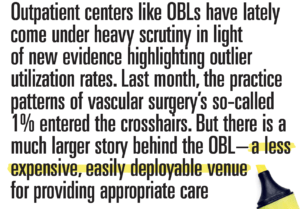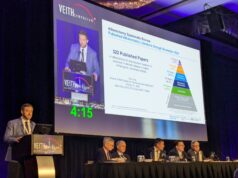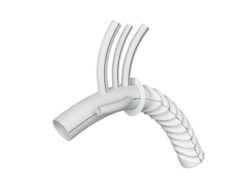
Vascular surgery has undergone dramatic changes over the last 30 years. What was once a traditional open surgical discipline has now become a hybrid specialty that involves open surgery and endovascular techniques. As vascular surgeons became more adept at endovascular interventions, the venue in which to do these procedures became more important.
Initially, most interventions were done in the operating room (OR), where we were most familiar with the conduct of that environment. But it did not take long to realize that there were fundamental limitations in imaging equipment and personnel expertise.
As time progressed, many cases began to migrate down to the cardiac catheterization lab. This created other issues, as we were now in competition with cardiologists for the limited resources of the lab. In many institutions, the cardiology service line created a tremendous financial windfall, which was hard to ignore. This meant that vascular surgeons were not the most “favored nation,” and oftentimes our cases were pushed to later times in the day, if they were being done at all.
Also, during this time, the number of older patients increased substantially as baby boomers began to age up into the prime years of cardiovascular disease. This resulted in a higher caseload. The advent of and progression in development of newer endovascular techniques and devices meant that even older patients were candidates for intervention, as well as many patients who previously had few endovascular options. Over time, these changes created a tremendous volume of procedures that needed to be done.
At an institutional level, there was a contemporaneous increase in consolidation, and an overall net reduction in available procedure rooms. With an increasing number of cases and no place to do them, something had to give.
It became clear that most endovascular cases could be done on an outpatient basis. With development of effective femoral artery closure devices, recovery times were brief after endovascular interventions. This led to the realization that these cases could be done in a different venue than the hospital—such as an ambulatory surgery center or even in an office.
In 2008, the Centers for Medicare & Medicaid Services (CMS) recognized that endovascular procedures could be done in an office setting (site of service 11) at a significant savings compared to hospital-based procedures. Available data supported the idea that procedures done in an office were as effective as those done in the hospital and did not compromise patient safety.
Since then, CMS has routinely reaffirmed the appropriateness of covering these procedures in the office setting. The number of office-based intervention centers has grown steadily through the years to now exceed more than 500 in the U.S. Most procedures done at office-based laboratories (OBLs) are dialysis access maintenance, lower-extremity interventions, venous interventions, and other minor vascular procedures. These cases are done using local anesthetics and, often, moderate sedation. Patients are sent home the same day.
From a patient’s perspective, these outpatient units are very well received. Most do not want to go to the hospital because they are generally dissatisfied with the experience there. Everything from parking to getting to the procedural unit can be distressingly complicated. Interactions with hospital personnel are often confusing and unsatisfying. Waiting times are long as complex pre-procedure protocols are followed. Patients may have to wait an unexpected period of time for other physicians to finish their cases prior to their own case starting. This inefficiency has only been aggravated by delays over the last year caused by COVID-19 and the inability of hospitals to maintain elective schedules for outpatient procedures during this time.
Improvement
In contrast, OBLs offer a much more patient-centric experience. The number of personnel that a patient interacts with is relatively limited. The venue is limited in size and not confusing to navigate. In some locations, you can park right outside the door. The procedure waiting time is usually short, as the OBL is more adept at predicting how long cases will take. The office staff, who are familiar with the patient, surgeon and case conduct, knows better when to schedule patients based on the planned procedures for the day. The protocols can be streamlined and shortened since there are no competing service lines.
Vascular surgeons, too, have found the OBL to be a substantial improvement over the hospital setting. A significant portion of a surgeon’s time at the hospital is spent waiting for things to happen prior to the case commencing. This may be a result of elaborate pre-procedure protocols, multiple stakeholders participating in the process, delays in accessing the room secondary to cases that may overrun scheduled times, and a general delay since often vascular cases are not the priority for the catheterization lab.
Generally, the lab decides what equipment will be available for the surgeon to use as many physicians may request the same equipment at the same time. Additionally, specialty items may not be available due to the vagaries of hospital value committees and the consensus of those running the lab.
In the OBL, the surgeon has complete discretion over the timing of the case, the equipment to be used, and the circumstances under which the case will proceed. Using a consistent team of personnel, many of the inefficiencies of working with people who do not normally participate in the care of your patients are eliminated.
Financial gains from the outpatient lab have been a longstanding point of concern and discussion by some.
From a financial perspective, with the continuous and repetitive decrease in payment for peripheral vascular procedures overall by the payors, and the increase in costs of rent, supplies and staffing, it has become more difficult for a surgeon to make a living doing only open and endovascular procedures in a pure hospital setting. The revenue generated solely from doing hospital-based cases is not adequate to provide reasonable compensation and cover increasing overhead costs for most independent (and even some employed) physicians.
For many vascular surgeons, the more expedient solution is to become employed by the hospital.
While this may be a practical solution to protect income, there are significant impositions on the surgeon’s time that can be frustrating, in addition to the loss of some autonomy that comes with the employment model.
Surgeon income
When working in an OBL, any excess margin goes directly to the financial benefit of the practice. Margin is defined as an excess of income over expenses. The expenses involved in an outpatient lab are not insignificant. When the reimbursement for an outpatient procedure is considered, keep in mind that a substantial portion of that cost is absorbed by both direct and indirect costs of owning and maintaining an OBL.
In general, it is financially better to do these procedures in an OBL as compared to a hospital from a surgeon income perspective. However, it is not necessarily the windfall it appears to be.
When these cases are done at the hospital, the total cost of the procedure is higher to the payor. There is excess margin that the hospital keeps on these procedures. Therefore, there is no net savings to the system based on doing these procedures at the hospital, and the only difference is that the surgeon does not benefit from the additional income compared to the overhead spent. The costs of rent supplies and staffing that are troublesome for private practice physicians (privately employed model) are covered in the employed model in part by the same technical fees paid to the hospital that are argued as a “windfall” for the outpatient labs.
What does this mean as a practical matter? Most of us continue to maintain hospital privileges and to take emergency room call. Without the additional benefit of our outpatient labs, we would not be able to afford the luxury of dealing with the hospital without having to be employed by the hospital. We genuinely care what goes on with our patients, and if there are any issues, we want to be able to address them ourselves in the hospital.
Resources
As is true for all professionals, we are in the business of using our time and expertise to help our patients and to earn a living. Our expertise has no practical expiration date, but our time does. Traditional open surgical procedures, particularly those that involve revascularization of the lower extremities, are time- and labor-intensive procedures. There simply are not enough vascular surgeons—nor OR time—to address all the limbs that are in jeopardy.
While many patients may require (and benefit from) open surgical procedures, endovascular interventions are safe and effective in salvaging limbs when done with appropriate indications. The OBL allows a less expensive, easily deployable venue for providing appropriate care to patients in a very satisfying setting for the patient and the provider.
The Society for Vascular Surgery (SVS) recognizes the value of the outpatient lab as an appropriate setting for vascular patient care.
Although some of the SVS members in a current employed model are prohibited from participating in the OBL, many SVS members who have busy inpatient practices with excellent quality outcomes also participate in an outpatient lab for reasons outlined. In 2018, the Section on Outpatient and Office Vascular Care (SOOVC) was created by the SVS to address increasing member support of this particular venue.
This year there will be several initiatives related to OBLs, including how to decide if this is right for your practice. We encourage all SVS members to join the SOOVC to stay abreast of new developments and have a better understanding of what these labs may provide for our practices.
Dennis Gable, MD, Daniel T. McDevitt, MD, Robert Molnar, MD, and Patrick Ryan, MD, are private practice vascular surgeons who operate office-based labs in Dallas, Atlanta, Flint, Michigan, and Nashville, respectively.












